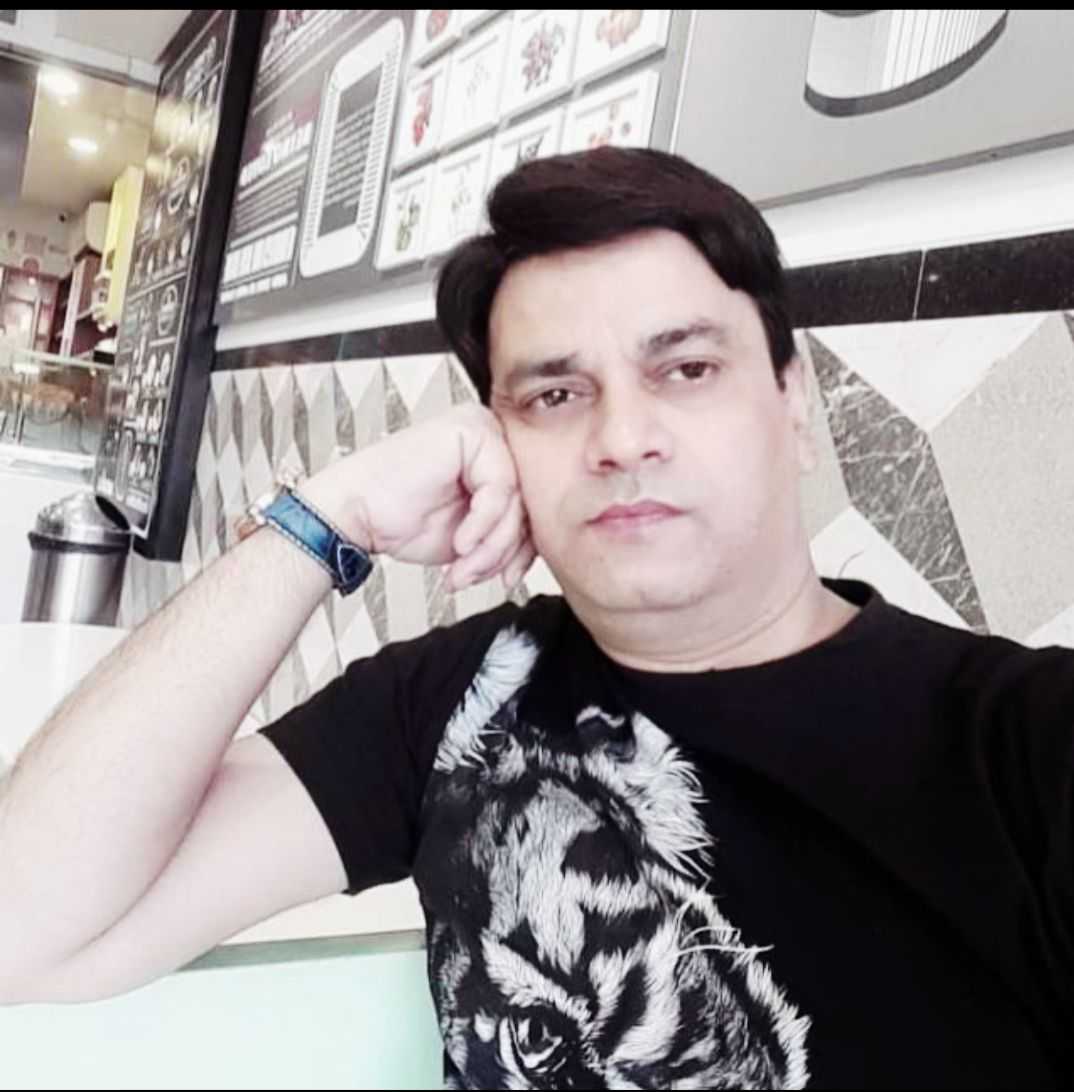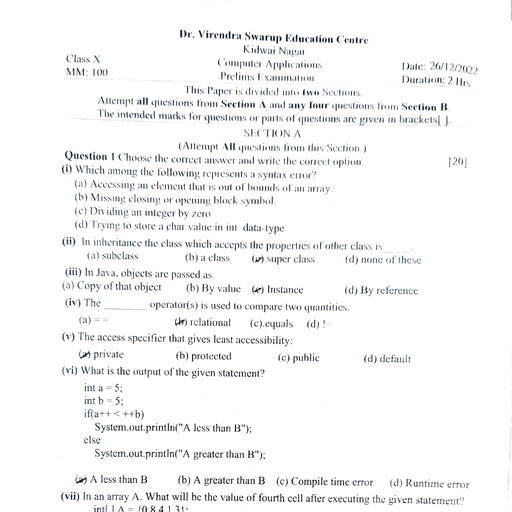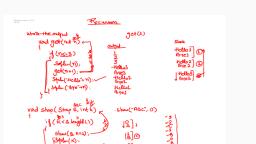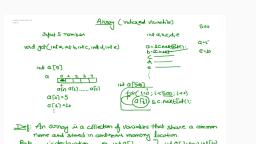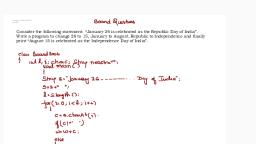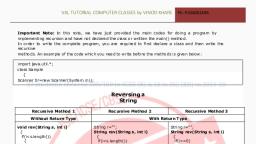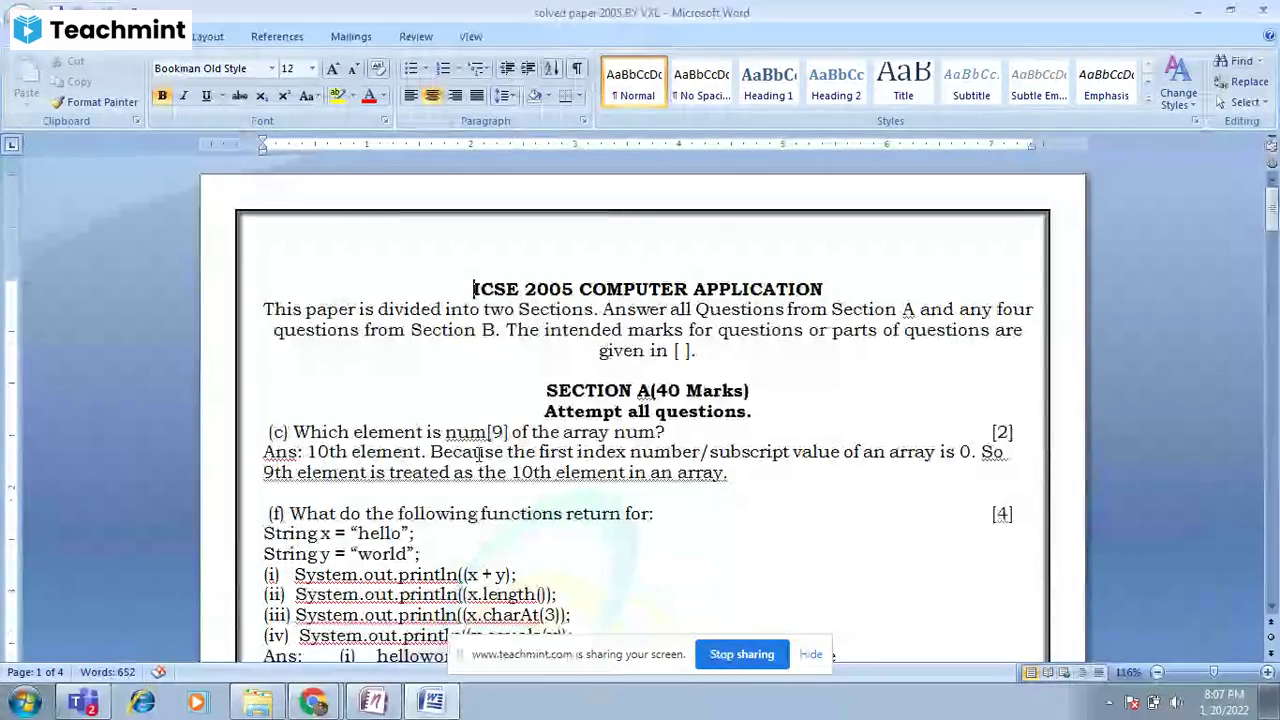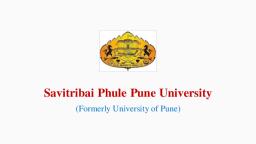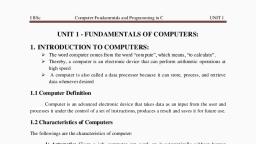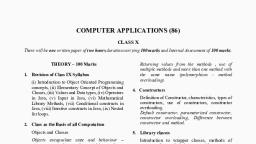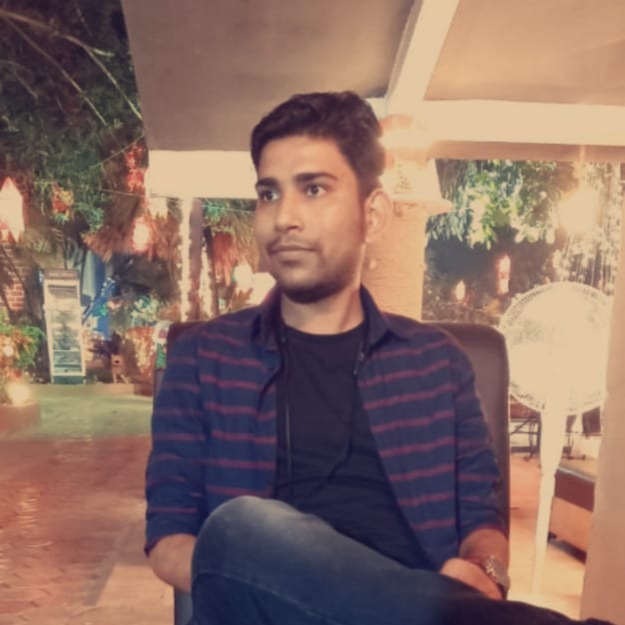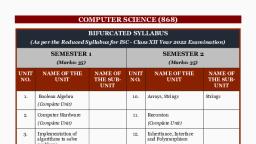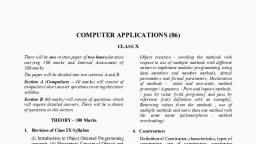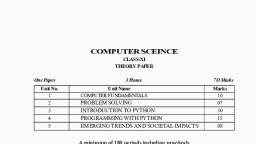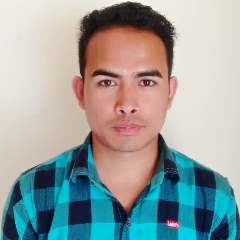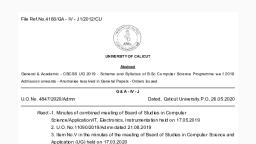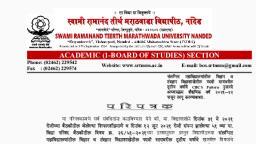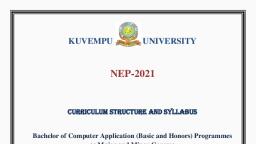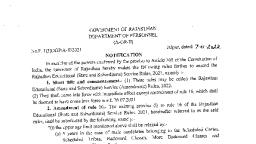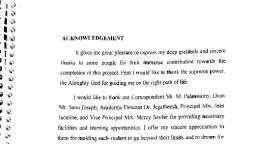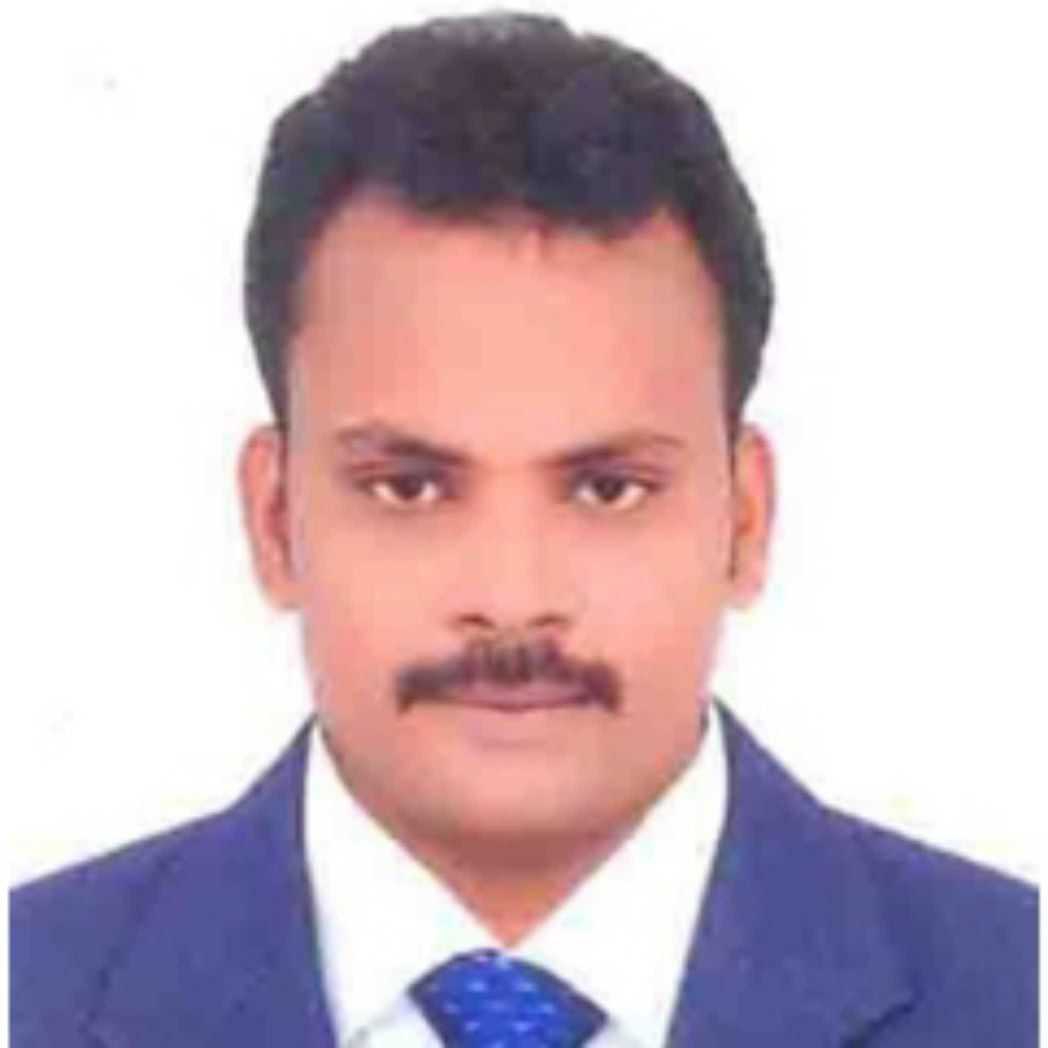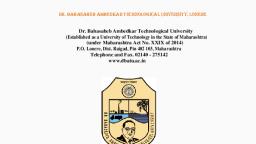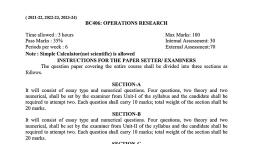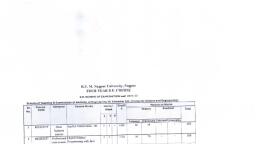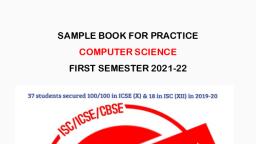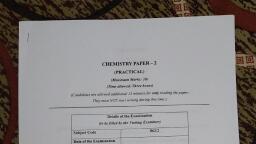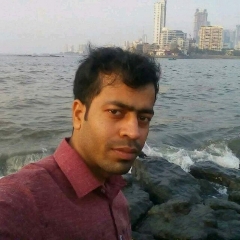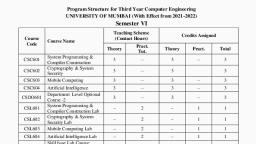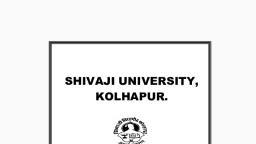Page 1 :
COMPUTER SCIENCE (868), CLASS XII, There will be two papers in the subject:, Paper I: Theory……….., , 3 hours….70 marks, , Paper II: Practical…….., , 3 hours….30 marks, , Morgan’s laws; law of implication (p ⇒ q ≡, ~p ∨ q); law of biconditional ((p ⇔ q) ≡, (p ⇒ q) ∧ (q ⇒ p)); identity (p ≡ p); law of, negation (~ (~p) ≡ p); law of excluded middle, (p ∨~p ≡ true); law of contradiction (p∧~p ≡, false);, tautology, and, contingency, simplification rules for ∧, ∨. Converse,, inverse and contra positive., , PAPER I –THEORY – 70 MARKS, Paper I shall be of 3 hours duration and be divided, into two parts., Part I (20 marks): This part will consist of, compulsory short answer questions, testing, knowledge, application and skills relating to the entire, syllabus., , (b) Binary valued quantities; basic postulates, of Boolean algebra; operations AND, OR and, NOT; truth tables., , (c) Basic theorems of Boolean algebra, (e.g. duality, idempotence, commutativity,, associativity, distributivity, operations with 0, and 1, complements, absorption, involution);, De Morgan’s theorem and its applications;, reducing Boolean expressions to sum of, products and product of sums forms;, Karnaugh maps (up to four variables)., , Part II (50 marks): This part will be divided into, three Sections, A, B and C. Candidates will be, required to answer two questions out of three from, Section A (each carrying 10 marks) and two questions, out of three from Section B (each carrying 10 marks), and two questions out of three from Section C (each, carrying 5 marks). Therefore, a total of six questions, are to be answered in Part II., , Verify the laws of Boolean algebra using truth, tables. Inputs, outputs for circuits like half, and full adders, majority circuit etc., SOP and, POS representation; Maxterms & Minterms,, Canonical and Cardinal representation,, reduction using Karnaugh maps and Boolean, algebra., , SECTION A, 1. Boolean Algebra, (a) Propositional logic, well formed formulae,, truth values and interpretation of well formed, formulae (wff), truth tables, satisfiable,, unsatisfiable and valid formulae. Equivalence, laws and their use in simplifying wffs., , 2. Computer Hardware, (a) Elementary logic gates (NOT, AND, OR,, NAND, NOR, XOR, XNOR) and their use in, circuits., , Propositional variables; the common logical, ∧, connectives, (~, (not)(negation),, (and)(conjunction), ∨ (or)(disjunction), ⇒, (implication), ⇔ (biconditional); definition of, a well-formed formula (wff); `representation, of simple word problems as wff (this can be, used for motivation); the values true and, false; interpretation of a wff; truth tables;, satisfiable, unsatisfiable and valid formulae., Equivalence laws: commutativity of ∧, ∨;, associativity of ∧, ∨; distributivity; De, , (b) Applications of Boolean algebra and logic, gates to half adders, full adders, encoders,, decoders, multiplexers, NAND, NOR as, universal gates., Show the correspondence between Boolean, methods and the corresponding switching circuits, or gates. Show that NAND and NOR gates are, , 1
Page 2 :
(c) Basic input/output using Scanner from JDK;, input/output exceptions. Tokens in an input, stream, concept of whitespace, extracting, tokens from an input stream (String Tokenizer, class)., , universal by converting some circuits to purely, NAND or NOR gates., SECTION B, The programming element in the syllabus (Sections B, and C) is aimed at algorithmic problem solving and, not merely rote learning of Java syntax. The Java, version used should be 5.0 or later. For programming,, the students can use any text editor and the javac and, java programs or any other development environment:, for example, BlueJ, Eclipse, NetBeans etc. BlueJ is, strongly recommended for its simplicity, ease of use, and because it is very well suited for an ‘objects first’, approach., 3. Implementation, problems, , of, , algorithms, , to, , 6. Primitive values, Wrapper classes, Types and, casting, Primitive values and types: byte, int, short, long,, float, double, boolean, char. Corresponding, wrapper classes for each primitive type. Class as, type of the object. Class as mechanism for user, defined types. Changing types through user, defined casting and automatic type coercion for, some primitive types., , solve, , 7. Variables, Expressions, Variables as names for values; named constants, (final), expressions (arithmetic and logical) and, their, evaluation, (operators,, associativity,, precedence). Assignment operation; difference, between left hand side and right hand side of, assignment., , The students are required to do lab assignments in, the computer lab concurrently with the lectures., Programming assignments should be done such, that each major topic is covered in at least one, assignment. Assignment problems should be, designed so that they are sufficiently challenging., Students must do algorithm design, address, correctness issues, implement and execute the, algorithm in Java and debug where necessary., , 8. Statements, Scope, Statements; conditional (if, if else, if else if,, switch case, ternary operator), looping (for, while,, do while, continue, break); grouping statements in, blocks, scope and visibility of variables., , Self explanatory., 4. Programming in Java (Review of Class XI, Sections B and C), , 9. Methods, , Note that items 4 to 13 should be introduced, almost simultaneously along with classes and, their definitions., , Methods (as abstractions for complex user defined, operations on objects), formal arguments and, actual arguments in methods; Static method and, variables. The this Operator. Examples of, algorithmic problem solving using methods, (number problems, finding roots of algebraic, equations etc.)., , While reviewing, ensure that new higher order, problems are solved using these constructs., 5. Objects, (a) Objects as data (attributes) + behaviour, (methods); object as an instance of a class., Constructors., , 10. Arrays, Strings, Structured data types – arrays (single and multidimensional), address calculations, strings., Example algorithms that use structured data types, (e.g. searching, finding maximum/minimum,, , (b) Analysis of some real-world programming, examples in terms of objects and classes., , 2
Page 3 :
SECTION C, , sorting techniques, solving systems of linear, equations, substring, concatenation, length, access, to char in string, etc.)., , Inheritance,, structures, , Storing many data elements of the same type, requires structured data types – like arrays., Access in arrays is constant time and does not, depend on the number of elements. Address, calculation (row major and column major),, Sorting techniques (bubble, selection, insertion)., Structured data types can be defined by classes –, String. Introduce the Java library String class and, the basic operations on strings (accessing, individual, characters,, various, substring, operations, concatenation, replacement, index of, operations)., , Interface,, , Polymorphism,, , Data, , 12. Inheritance, Interfaces and Polymorphism, (a) Inheritance; super and derived classes;, member access in derived classes; redefinition, of variables and methods in subclasses;, abstract classes; class Object; protected, visibility. Subclass polymorphism and, dynamic binding., Emphasize inheritance as a mechanism to, reuse a class by extending it. Inheritance, should not normally be used just to reuse, some methods defined in a class but only, when there is a genuine specialization (or, subclass) relationship between objects of the, super class and that of the derived class., , 11. Recursion, Concept of recursion, simple recursive methods, (e.g. factorial, GCD, binary search, conversion of, representations of numbers between different, bases)., , (b) Interfaces in Java; (Conceptual), Emphasize the difference between the Java, language construct interface and the word, interface often used to describe the set of, method prototypes of a class., , Many problems can be solved very elegantly by, observing that the solution can be composed of, solutions to ‘smaller’ versions of the same, problem with the base version having a known, simple solution. Recursion can be initially, motivated by using recursive equations to define, certain methods. These definitions are fairly, obvious and are easy to understand. The, definitions can be directly converted to a, program. Emphasize that any recursion must have, a base case. Otherwise, the computation can go, into an infinite loop., , 13. Data structures, (a) Basic data structures (stack, queue,, implementation directly through classes;, definition through an interface and multiple, implementations by implementing the, interface. Conversion of Infix to Prefix and, Postfix notations., Basic algorithms and programs using the, above data structures., , The tower of Hanoi is a very good example of how, recursion gives a very simple and elegant solution, where as non-recursive solutions are quite, complex., , (b) Binary trees, tree traversals (Conceptual)., The following should be covered, Binary trees: apart from the definition the, following concepts should be covered: root,, internal nodes, external nodes (leaves),, height (tree, node), depth (tree, node), level,, size, degree, siblings, sub tree, completeness,, balancing, traversals (pre, post and in-order)., , 3
Page 4 :
are expected to do a minimum of twenty assignments, for the year., , PAPER II: PRACTICAL – 30 MARKS, This paper of three hours’ duration will be evaluated, by the Visiting Examiner appointed locally and, approved by the Council., , EVALUATION:, Marks (out of a total of 30) should be distributed as, given below:, , The paper shall consist of three programming, problems from which a candidate has to attempt any, one. The practical consists of the two parts:, , Continuous Evaluation, Candidates will be required to submit a work file, containing the practical work related to programming, assignments done during the year., , 1. Planning Session, 2. Examination Session, The total time to be spent on the Planning session and, the, Examination, session is, three, hours., A maximum of 90 minutes is permitted for the, Planning session and 90 minutes for the Examination, session., , Programming, assignments, done 10 marks, throughout the year (Internal Evaluation), Programming, assignments, done 5 marks, throughout the year (Visiting Examiner), , Candidates are to be permitted to proceed to the, Examination Session only after the 90 minutes of, the Planning Session are over., , Terminal Evaluation, , Solution to programming problem on, the computer, , Planning Session, , 15 Marks, , Marks should be given for choice of algorithm and, implementation strategy, documentation, correct output, on known inputs mentioned in the question paper,, correct output for unknown inputs available only to the, examiner., , The candidates will be required to prepare an, algorithm and a hand written Java program to solve, the problem., Examination Session, The program handed in at the end of the Planning, session shall be returned to the candidates. The, candidates will be required to key-in and execute the, Java program on seen and unseen inputs individually, on the Computer and show execution to the Visiting, Examiner. A printout of the program listing including, output results should be attached to the answer script, containing the algorithm and handwritten program., This should be returned to the examiner. The program, should be sufficiently documented so that the, algorithm, representation and development process is, clear from reading the program. Large differences, between the planned program and the printout will, result in loss of marks., , NOTE:, Algorithm should be expressed clearly using any, standard scheme such as a pseudo code., EQUIPMENT, There should be enough computers to provide for a, teaching schedule where at least three-fourths of the, time available is used for programming., Schools should have equipment/platforms such that all, the software required for practical work runs properly,, i.e. it should run at acceptable speeds., Since hardware and software evolve and change very, rapidly, the schools may have to upgrade them as, required., , Teachers should maintain a record of all the, assignments done as part of the practical work through, the year and give it due credit at the time of, cumulative evaluation at the end of the year. Students, , Following are the recommended specifications as of, now:, , 4
Page 5 :
Software:, , The Facilities:, •, , A lecture cum demonstration room with a, MULTIMEDIA PROJECTOR/ an LCD and, O.H.P. attached to the computer., , •, , A white board with white board markers should, be available., , •, , A fully equipped Computer Laboratory that, allows one computer per student., , •, , Internet connection for accessing the World, Wide Web and email facility., , •, , The computers should have a minimum of, 1 GB RAM and a P IV or higher processor. The, basic requirement is that it should run the, operating system and Java programming system, (Java compiler, Java runtime environment, Java, development environment) at acceptable speeds., , •, , Good Quality printers., , •, •, •, •, , 5, , Any suitable Operating System can be used., JDK 6 or later., Documentation for the JDK version being used., A suitable text editor. A development, environment with a debugger is preferred, (e.g., BlueJ, Eclipse, NetBeans). BlueJ is, recommended for its ease of use and simplicity.
Page 6 :
SAMPLE TABLE FOR PRACTICAL WORK, , S. No., , Unique, Identification, Number (Unique, ID) of the candidate, , Assessment of, Practical File, Internal, Evaluation, 10 Marks, , Visiting, Examiner, 5 Marks, , Assessment of the Practical Examination, (To be evaluated by the Visiting Examiner only), Algorithm, 3 Marks, , Java Program with, internal, Documentation, 7 Marks, , Hard, Copy, (printout), 2 Marks, , Output, 3 Marks, , TOTAL MARKS, (Total Marks are to, be added and, entered by the, Visiting Examiner), 30 Marks, , 1., 2., 3., 4., 5., 6., 7., 8., 9., 10., , Name of the Visiting Examiner:_________________________________, Signature: _______________________________, Date:___________________________________, 6
